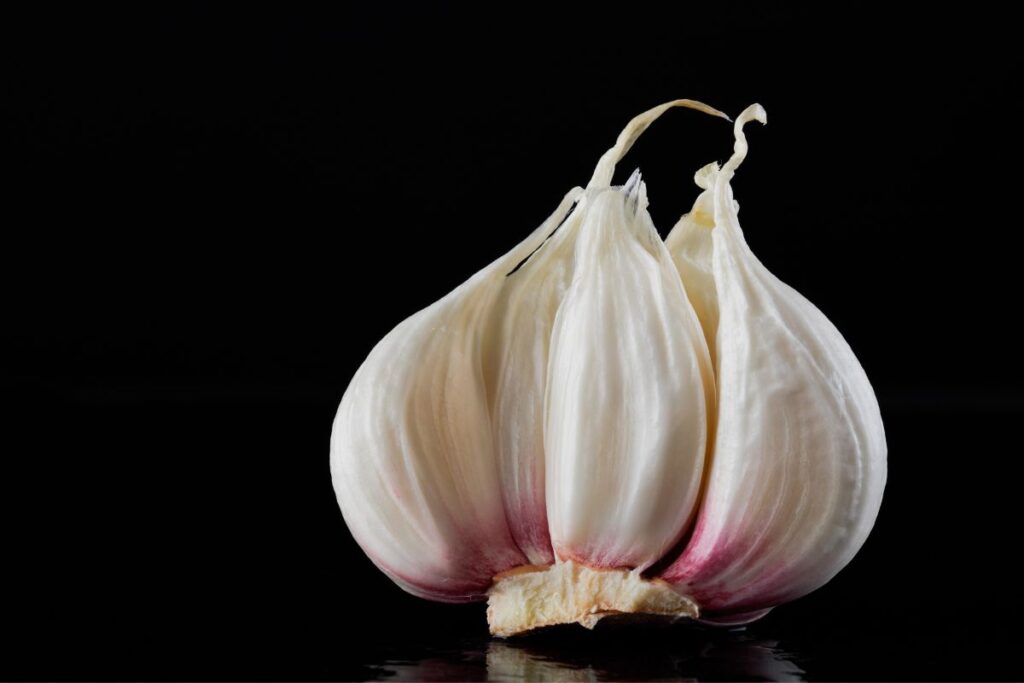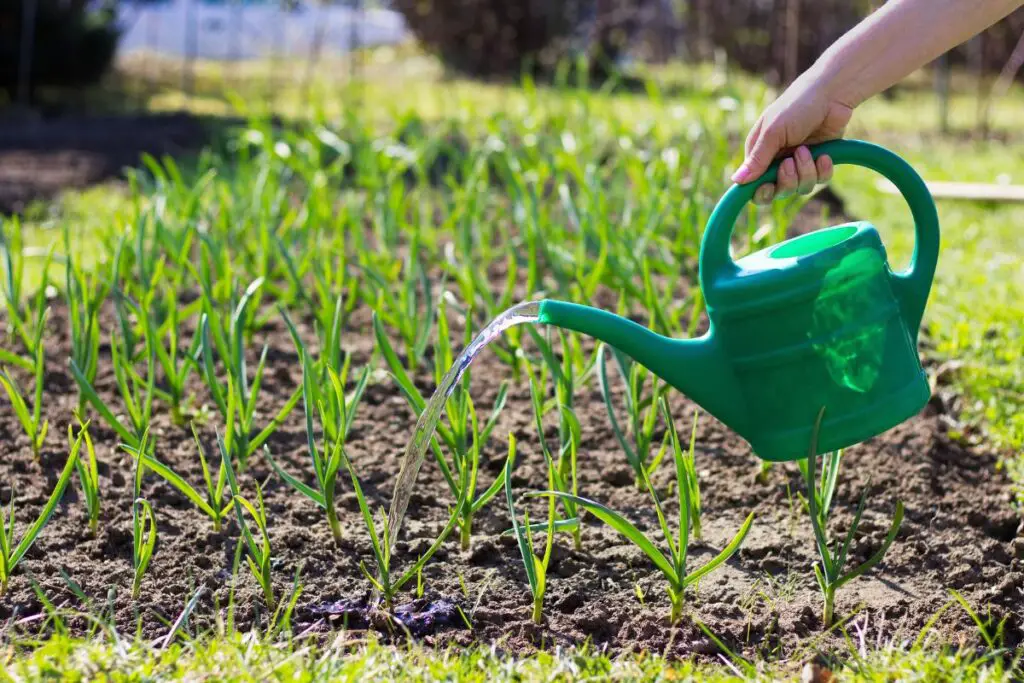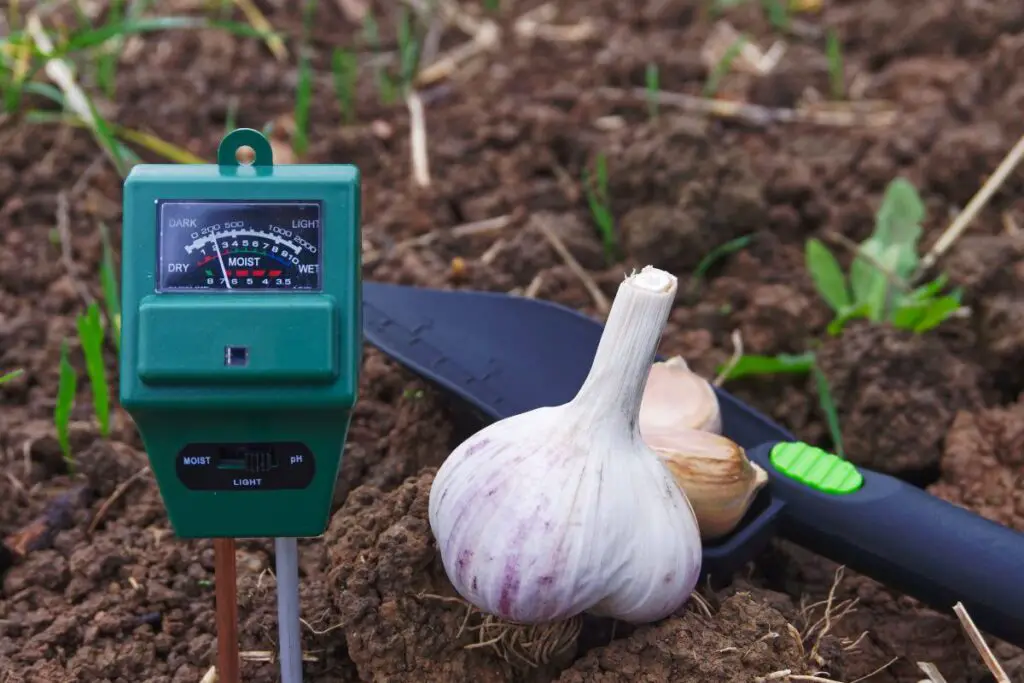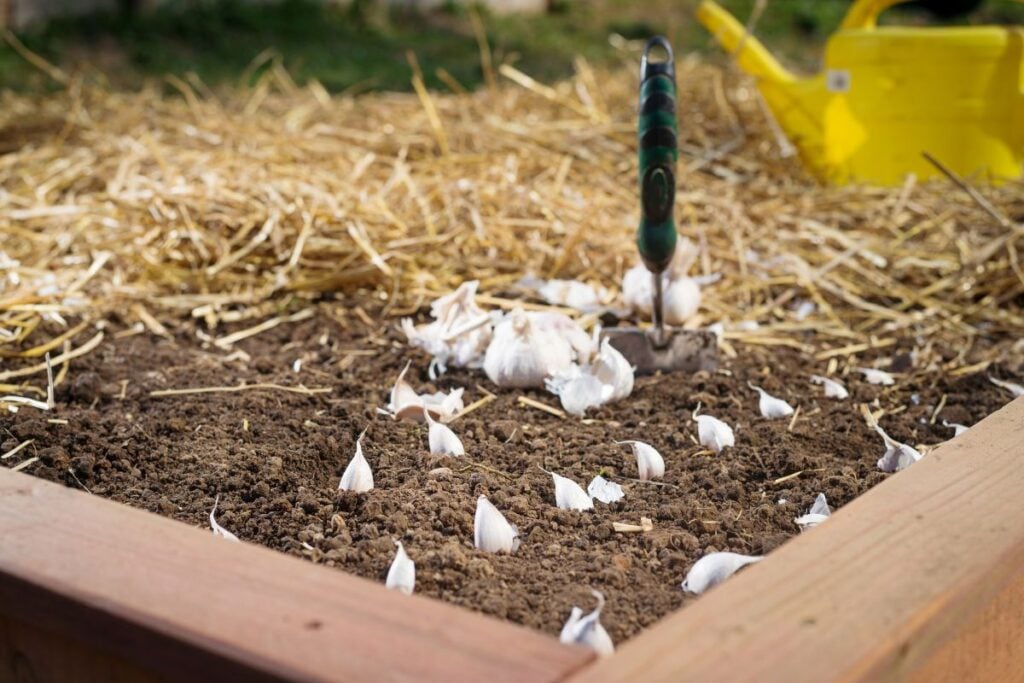Garlic is famous for its flavor and health benefits and is easy to grow. But, it will face certain issues if not planted or maintained properly. A common problem is bulbs splitting up in the ground.
Generally, the garlic bulbs split open when you harvest them late and keep them in the ground for a long time. To prevent this, you should harvest when the plant turns yellow, and the leaves start wilting, but before the whole plant dies.
However, there are some other reasons which we will discuss in this article. We will also share the ways of dealing with the problems and preventing them.

Why are my garlic bulbs splitting up?
When you plant the cloves in the fall, it turns out to be a big and compact garlic bulb after some 8-9 months.
But, when you pick them up and find them to have split up, the bulbs have faced something wrong.
Let’s find out what are those reasons for which the bulbs have split up on their own.
Letting bulbs stay in the ground for a long time
Late harvest is one of the most common reasons behind garlic bulbs splitting up underground on their own.
Generally, garlic gets ready for harvest after 8-9 months.
Sometimes, garlic could get ready before this time, depending on the weather conditions, their care, and the variety.
But, if you let the bulbs stay in the ground for a long time, the bulbs will open up and begin to rot.
It is always not possible to depend on the leaf conditions.
Sometimes, you must remove the soil to check the bulb conditions.
What should be done?
If planted in the fall, the bulbs get ready to harvest in the months of summer.
However, you can wait a little longer if the weather is too hot.
But, it would be best if you did not let the bulbs stay underground for a long time.
To understand when to harvest the bulbs, check the leaves carefully.
Half of the leaves will become yellow or brown, and half the leaves at the top will remain green.
Also, consider checking the bulb size by digging the soil a bit.
Harvest the bulbs if you think they have reached their desired size.
Also read: When Is Garlic Ready To Harvest? (+How To)
Looking for gardening supplies? We have tested 100's of products before recommending them to you guys. Check out our best pick below:
| Image | Gardening Supplies | Best Price? |
|---|---|---|
 Top
Top Top
Top | Raised Garden Bed Kit | Check On Amazon |
 | XLUX Soil Moisture Meter, Plant Water Monitor, Soil Hygrometer Sensor for Gardening, Farming, Indoor and Outdoor Plants, No Batteries Required | No Results |
 Top
Top Top
Top | 82 Pcs Garden Tools Set and Extra Succulent Tools Set | Check On Amazon |
 | Joeys Garden Expandable Garden Hose with 8 Function Hose Nozzle, Lightweight Anti-Kink Flexible Garden Hoses, Extra Strength Fabric with Double Latex Core, (50 FT, Black) | No Results |
 Top
Top Top
Top | Dual Chamber Compost Tumbler | Check On Amazon |
 Top
Top Top
Top | Sunnyglade Plant Stakes | Check On Amazon |
 Top
Top Top
Top | Organic Cold Pressed Neem Seed Oil | Check On Amazon |
 Top
Top Top
Top | Mighty Mint Gallon :-Insect and Pest Control Peppermint Oil | Check On Amazon |
 Top
Top Top
Top | Scotts DiseaseEx Lawn Fungicide | Check On Amazon |
 Top
Top Top
Top | Jacks Classic 20-20-20 All Purpose Fertilizer | Check On Amazon |
 Top
Top Top
Top | 30,000 Seeds Pollinator Attracting Wildflower Mixture | Check On Amazon |
 Top
Top Top
Top | Survival Vegetable Seeds Garden Kit-Over 16,000 Seeds | Check On Amazon |
Improper watering

Not watering the garlic plants properly can make the bulbs split up.
Excessive water can give rise to certain diseases, for which the bulbs may rot and split up under the ground.
The other common signs of overwatering are floppy plants, yellow leaves, or no garlic heads coming out.
How to fix the problem?
You must water the plant once the top 1-2 inches have dried up.
To follow up a routine, water them every 3-5 days.
Reduce the frequency of 7-10 days if there are rains.
During extreme rain, it is better to cover them up.
Otherwise, the moisture in the soil won’t dry up and cause overwatering again.
In the winters, you don’t have to water them.
Since they will remain dormant, they will not absorb any water.
Never keep the garlic plants dehydrated for a very long time.
Always water them to maintain consistently moist soil.
Check the moisture level before watering.
Also read: How Much Water Do Garlic Plants Need? (+How Often)
Bloat nematode
A nematode named Ditylenchus Dipsaci is a common garlic bug.
The bug enters through the plant wounds and creates galls inside the plant.
Besides feeding on the fungi, bacteria, and mites, they will feed on the plant’s tissue.
They will also eat the garlic bulb flesh, causing stem and bulb rot.
This bloat nematode makes the garlic bulbs twist, split up in the ground, turn brown, and swell or bloat.
Sometimes, the wrappers crack and get detached from the basal plate.
How to get rid of nematodes?
It would be best to plant a disease-free seed or clove to prevent this bug.
Consider crop rotation with biofumigant crops like brown mustard and sudangrass.
Carefully remove the garlic bulbs at the time of harvest.
Nematodes like to eat dead and dried tissue.
Before planting, make sure that your planting site is free of dead materials.
If you have planted any allium crops in a particular place and got attacked by any nematodes, avoid planting garlic in the same location.
Even if the previous crop was fine, it is still better to avoid the place.
Avoid planting celery, hydrangeas, alfalfa, parsley, or other flower bulbs in consecutive years.
These plants could be a good food source for nematodes.
Keep your garden clean and hygienic, and remove the weeds.
Clean your garden tools before and after use to avoid the bugs from staying around your garden.
If, by chance, any nematodes are present in the seeds or cloves, soak them in warm water heated at 120°F for 20 minutes.
Nematodes are tiny microscopic worms that can spread from your garden tools and even your shoes.
Releasing five million Sf nematodes over 1600 square feet can kill the bad nematodes.
Spraying a neem oil solution can also kill the bad nematodes, keeping the good ones unharmed.
To make a neem oil solution:
- Add 1 teaspoon of the neem oil with ½ teaspoon of dishwashing soap and 1 quarter of warm water.
- Add well and spray on the affected parts.
- Use them once a week until the problem resolves.
Temperature fluctuations

In some places, the temperature has extreme fluctuations in winter.
One day, the winter temperature is extremely low, accompanied by snowfall.
The next day, you might get heated temperatures common in the spring or summer.
When the temperature gets heated, the garlic gets triggered and sprouts, forming bulbs and cloves.
Again, the bulbs will stop growing and forming when the temperature drops.
Sometimes, the temperature remains cold again, but the soil is still not yet cold due to the previous heat they received.
These temperature fluctuations can confuse the bulbs whether to grow or not to grow.
The hot weather triggers them to grow, and suddenly the temperature drops and stops their growth, thus resulting in half-sprouted and split-up bulbs.
This condition is called frost heave, where the bulbs receive constant frost temperature followed by soil defrost.
Besides splitting up the bulbs, frost heave cracks the soil, displaces the bulbs, and tears their tender roots.
In most situations, the bulbs will face this condition when you don’t cover the bulbs well.
Also read: Garlic Plant Temperature Tolerance: Ideal Temperature+Extreme
What should be done?
You cannot control the temperature.
But if your region is familiar with experiencing such temperature fluctuations, you can freeze the garlic bulbs before planting.
Or, you can mulch them pretty well with a thick 6 inches layer of straw or leaves.
This mulch will stop the temperatures from reaching the bulbs and activate their growth when the temperature warms up.
You can cover your bulbs with many things:
- Agrofiber: It is a synthetic polypropylene film. It doesn’t accumulate moisture or freeze the garlic and gives them light.
- Peat: Peat is a good heat-insulating ingredient that can save the cloves from extreme frost.
- Fallen leaves: Dry and fallen leaves are easily-available mulching materials with a good air circulation facility. The problem is they might carry fungi and pests.
- Sawdust: It is another good mulch with a high thermal insulation range. Besides, it can absorb and hold moisture. But it is weak in warming up the ground.
- Plant stems: These can hold the snow and prevent the soil from getting over-moistened.
What should I do with the split bulbs?
When you take the plant out of the ground during harvest and find out some bulbs have split open, they are no longer capable of storage,
It would be best if you immediately used those fresh, split-up bulbs for cooking or planting again.
Storing them will only degrade their quality and make them unable to use for other purposes.
Once the bulb breaks and splits up, its shelf life decreases and remains up to only 3-10 days.
So, it is better to use them immediately, either in cooking or by planting them back again to the ground.
But before planting, you need to consider the weather conditions and then plant them.
How do you break garlic cloves for planting?

Garlic bulbs have many cloves in various sizes-small, medium and big.
The papery outside skin holds the bulb together and protects the cloves.
Garlic planted in the fall prepares for harvest in summer and sometimes before summer.
Here are the simple steps to break the garlic cloves for planting:
- Open the thick, papery layer of the bulbs holding the cloves together. Also, remove the outermost skin to get the cloves inside.
- Now, separate the cloves one by one by one. Force open between the cloves near the pointed bulb end and lift the outer cloves from the inner ones.
- Please don’t remove the outer skin of the individual cloves, and don’t crush or damage them while dividing.
- Separate the smaller cloves from the bigger ones and keep the latter aside for planting. Bigger cloves can reward you with bigger garlic bulbs.
- If any cloves get hurt, crushed, or split by mistake, keep them away from the other cloves and use them in cooking.
- If you don’t want any small bulbs, use the small ones for cooking and the larger ones for planting.
- You should do this separation process just before the planting. If you keep the separated cloves aside and don’t plant them in time, they will become prone to damage and rotting.
- Find a sunny location with well-drained soil and plant the cloves 2-4 inches deep and 4-6 inches apart.
Why is garlic not forming cloves?
Sometimes, garlic doesn’t form any cloves.
Garlic requires at least 30-40°F for 30-40 days to form the cloves.
If you ever dig up a bulb and find out that there is a small or no bulb, the clove might not be ready, or it did not receive the cold temperature which triggers bulb growth.
Sometimes, it is the variety.
You might be growing a variety that is not ideal for your living zone.
For example, Hardneck varieties are native to zones 2-9.
They need the cold of these zones to activate growth.
If you grow Hardneck garlic in warmer zones, you have to store them in the refrigerator before planting.
Otherwise, you won’t see any bulbs or cloves.
Or, grow garlic variety depending on the zone.
Extreme weather sometimes stunts the growth, causing no bulbs or cloves.
Pests are another reason.
Thrips and nematodes are famous for stunting garlic growth. As a result, your garlic won’t form any cloves.
You must identify the pest and take immediate action to remove them, for example, through crop rotation, spraying neem oil, etc.
Final thoughts
For many reasons, garlic bulbs can split up before taking out from the ground. To prevent it, you should know the reasons and avoid creating situations where they can split.
Don’t let the bulbs stay in the ground for too long. When half of the lower leaves turn yellow or brown, and the upper leaves are green, harvest them if they have reached the desired size.
Avoid inconsistent watering. Water the plants when the top 1-2 inches of the soil has dried. Never keep your plant dehydrated, and don’t create a water pool around them. Avoid watering during the winters as they remain dormant.
You will not see bulb heads sprouting out if the plant gets infested. In that case, check whether it is a nematode or not, and take immediate steps to deter them.
Don’t forget to mulch the cloves when temperatures start dropping down. Add a thick 6 inches layer of mulch so that the cloves don’t get affected much by frost heave.
Reference: The Pennsylvania State University, Garlic Production for the Gardener, University of Massachusetts Amherst, Ohio State University Extension.

Thank you for your sharing. I am worried that I lack creative ideas. It is your article that makes me full of hope. Thank you. But, I have a question, can you help me?
Sure, you can let me know your doubts and I will be happy to help!